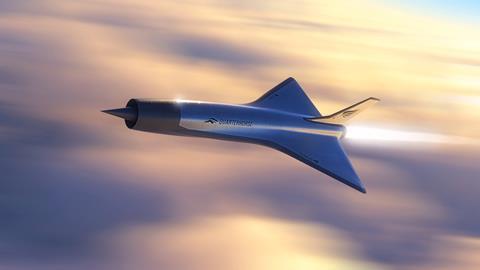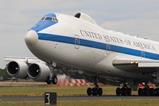Hypersonic development start-up Hermeus has revealed new details about the supersonic aircraft the company plans to fly next year.
Quarterhorse Mk 2 will be the second flight vehicle and third airframe in the company’s Quarterhorse line. It represents the first attempt by Hermeus to break the sound barrier.
In a 4 April social media post, the Atlanta-based manufacturer described the Mk 2 as “the world’s first high-Mach autonomous aircraft”.
The experimental type will feature a delta wing, a variable air intake and be “about the size of a [Lockheed Martin] F-16”, Hermeus says.
Notably, Quarterhorse Mk 2 will feature the same engine that powers the iconic F-16 – Pratt & Whitney’s F100.

However, in the case of Quarterhorse, the F100 powerplant will be pre-cooled, according to Hermeus. Pre-cooling intake air before compression allows the turbofan engine to operate at higher speeds with greater efficiency and reduced performance degradation.
While Hermeus has not revealed design specifics, pre-cooling can be accomplished using a heat exchanger and a cryogenic fuel, such as liquid hydrogen.
The F-16 and Boeing F-15 fighters do not use pre-cooling technology with their F100 engines. P&W tells FlightGlobal that Hermeus will be developing the pre-cooler technology.
Hermeus says it plans to make the first flight with Quarterhorse Mk 2 sometime in 2025.
The Mk 2’s predecessor – Quarterhorse Mk 1 – is scheduled to lift off later this year. Hermeus in March revealed the upcoming flight, which will take place at the US Air Force’s Edwards AFB in California.
The subsonic Mk 1 represents the first flight-capable vehicle in the Hermeus line, with Mk 0 being a ground-based test article.
A fourth iteration – Quarterhorse Mk 3 – will attempt to break the Mach 5 hypersonic barrier.
Hermeus has set the goal of making the Mk 3 the world’s fastest aircraft, by breaking the current airspeed record established by Lockheed’s SR-71 Blackbird nearly 50 years ago.
In 1976, one of the twin-engined Blackbirds reached a velocity of 1,905kt (3,529km/h) – or M3.3, according to the USA’s Smithsonian National Air and Space Museum.
Since announcing that goal, Hermeus has made rapid aircraft development a pillar of the company’s strategy.
“One aircraft per year,” Hermeus said in the 3 April post.
The company says Quarterhorse Mk 0 was designed and built in under six months. The process took just seven months for the Mk 1 vehicle.
Chief executive AJ Piplica calls that approach the most important aspect of the Hermeus strategy, citing the rapid progression – and commercial success – of orbital rockets and small uncrewed air vehicles in recent years.
“We’re now bringing that power of iteration speed to aircraft,” he says. “It’s a capability that is absolutely necessary for solving the challenges of operationalising hypersonic aircraft.”
Longer-term, Hermeus plans to develop a “high-Mach drone” and a multi-mission hypersonic vehicle called Darkhorse, which will be tailored for defence and national security applications.
























